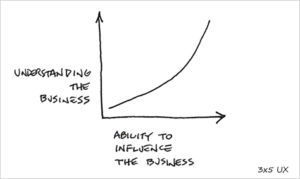
“Normally, we do not so much look at things as overlook them.”—Alan W. Watts
(“Usually we skim over things instead of taking a good look at them.”)
Original article by Liam Friedland
Published on uxmatters.com on March 9, 2015
Carry out a business case for the user experience
Developing new software is expensive. The design (design and integration of the user experience) generally represents 40% of the overall cost of software development. Therefore, on a $2 million project, designing the user experience will require approximately $800 of the budget. It is not a trivial sum. Obviously, the design and development of a product are not the only stages in the life of a project. There is the cost of marketing, advertising and selling the software as well as the cost of maintaining it after its release. The total cost of creating software can easily run into the millions of dollars.
To justify this cost, you must analyze the profitability of the user experience. Whether you're a user experience analyst, design professional, or leader of a UX team, you should use an analysis model to understand and describe the business value of the contribution that user experience makes to the whole. of the project. You should be able to present a complete user experience business plan to your hierarchy.
The UX value chain
An important model to consider is the value chain of a business. Professor Michael Porter developed the concept of the value chain, which describes the five steps companies follow in creating business value:
- Inbound logistics : How the company acquires equipment.
- operations : Conversion and processing of incoming material into goods or services.
- Marketing : Advertising and sale of products and services.
- Outbound logistics : Transport products to customers.
- Service : Provide additional services to keep customers happy.
Although Porter developed this value chain to describe traditionally produced products, this concept is useful for designing a business case that highlights the contributions and impacts of a UX team at every stage of the process. Let's examine each of these points.
Requirements and inbound logistics
For a software publisher, inbound logistics usually consists of incoming information that meets business demands and user needs, these are the main elements required. This usually results from:
- understanding the context of use of a product,
- recognition of differentiation opportunities,
- competitive market assessment,
- the exploitation of the analysis of user journeys,
- the evaluation of requests for improvement.
The user experience analyst is uniquely positioned to contribute a tremendous number of concepts in many of these areas. A well-structured UX research program digs deep into users' goals, activities, tasks, and can expose important processes and bottlenecks in work execution. Investing in UX research allows a company to develop a good understanding of the different roles within the company, how they work and what they require of their tools. Few other disciplines within business are better suited to exploring and describing these research topics.
operations
This is when the UX team shows what it can do. A well-managed UX design workflow can provide many valuable returns for a business, such as these:
- Quick and inexpensive exploration of several solutions and several alternative options.
- Creation of concepts in the form of prototypes that not only allow you to evaluate the effectiveness of solutions, but also help provide your team with a vision of how key elements of the product should come together and interact.
- Validation of design options with target users to ensure they fit their needs.
- Creating design specifications that allow development teams to work efficiently, without constantly having to stop and ask questions about how the product should work.
Marketing, outbound logistics and service
In today's world, most companies deliver their products through the cloud. In these environments, marketing, sales, outbound logistics, and services are very different from traditional methods of marketing physical products or software stored on discs. Marketing, sales, delivering your products to users and providing service are now an integral part of the user experience. Although companies often refer to this collectively as customer experience (CX), they are really extensions of user experience. And UX professionals have many, if not all, of the research, design, and validation skills that are needed to make a profound contribution to this field.
Ultimately, a high-quality, useful product that matches users' goals, activities, and tasks is much easier to sell than one that doesn't. This is true not only for products – for which people often make buying decisions quickly – but it is especially true for professional, enterprise products – whose evaluation cycles can be long and involve large decision-making teams.
Conclusion
Whether companies recognize it or not, design exists. And it has to go through a well-coordinated professional process if companies are to offer useful and thoughtful products and services.
Using Porter's Value Chain as an analytical framework for user experience, UX designers, strategists, managers, and leaders can break down their businesses and trace the many contributions of UX teams throughout the value chain.
Yannick Bonnieux, UX-Evangelist @ UX-Republic
STORYTELLING: THE ART OF CONVINCING # Paris
SMILE Paris
163 quay of Doctor Dervaux 92600 Asnières-sur-Seine
UX/UI ECO-DESIGN # Paris
SMILE Paris
163 quay of Doctor Dervaux 92600 Asnières-sur-Seine
DESIGN THINKING: CREATING INNOVATION # Belgium
UX-REPUBLIC Belgium
12 avenue de Broqueville - 1150 Woluwe-Saint-Pierre
MANAGING AND MEASURING UX # Paris
SMILE Paris
163 quay of Doctor Dervaux 92600 Asnières-sur-Seine
DESIGN SPRINT: INITIATION & FACILITATION # Paris
SMILE Paris
163 quay of Doctor Dervaux 92600 Asnières-sur-Seine
UX-DESIGN: THE FUNDAMENTALS # Belgium
UX-REPUBLIC Belgium
12 avenue de Broqueville - 1150 Woluwe-Saint-Pierre
GOOGLE ANALYTICS 4 #Paris
SMILE Paris
163 quay of Doctor Dervaux 92600 Asnières-sur-Seine
ACCESSIBLE UX/UI DESIGN # Belgium
UX-REPUBLIC Belgium
12 avenue de Broqueville - 1150 Woluwe-Saint-Pierre












